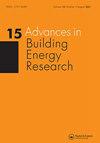Development of an optimization model for decision-making in building retrofit projects using RETROSIM
IF 2.5
Q2 CONSTRUCTION & BUILDING TECHNOLOGY
引用次数: 0
Abstract
ABSTRACT Nearly-zero energy buildings are standard for new constructions in the European Union. The challenge for decarbonized cities is retrofitting the existing buildings. Retrofitting the existing buildings provides considerable opportunities for improving occupants’ comfort and reducing global energy consumption and greenhouse gas emissions. Building retrofit is being considered one of the main approaches to achieve sustainability in the built environment at relatively low-cost and high-uptake rates. Although a broad range of retrofit technologies are readily available, methods to ascertain the most suitable set of retrofit actions for specific projects are still a practical challenge. This article first aims to develop and present a simulation-based multi-objective optimization model, named RETROSIM, to quantitatively assess technology choices in a building retrofit project. RETROSIM is a combination of a building energy simulation model and RETROSIM proprietary optimization engine. Secondly, in this study, RETROSIM is used to evaluate a building retrofit project as a case study to show the functionality of the proposed method. The study initiates with the single optimization of objective functions focusing on the building’s characteristics and performance: primary energy consumption, global costs and thermal discomfort hours. Then this methodology is used to study the interaction between these conflicting objectives and evaluate their trade-offs.基于RETROSIM的建筑改造项目决策优化模型的开发
摘要:在欧盟,几乎零能耗的建筑是新建筑的标准。脱碳城市面临的挑战是改造现有建筑。改造现有建筑为改善居住者的舒适度、减少全球能源消耗和温室气体排放提供了相当大的机会。建筑改造被认为是以相对低成本和高利用率实现建筑环境可持续性的主要途径之一。尽管各种各样的改造技术都很容易获得,但确定最适合具体项目的改造行动的方法仍然是一个实际挑战。本文首先旨在开发并提出一个基于仿真的多目标优化模型,名为RETROSIM,用于定量评估建筑改造项目中的技术选择。RETROSIM是建筑能源模拟模型和RETROSIM专有优化引擎的组合。其次,在本研究中,RETROSIM被用于评估一个建筑改造项目作为案例研究,以展示所提出的方法的功能。该研究首先对目标函数进行单一优化,重点关注建筑的特性和性能:一次能源消耗、全球成本和热不适时数。然后使用这种方法来研究这些相互冲突的目标之间的相互作用,并评估它们的权衡。
本文章由计算机程序翻译,如有差异,请以英文原文为准。
求助全文
约1分钟内获得全文
求助全文
来源期刊

Advances in Building Energy Research
CONSTRUCTION & BUILDING TECHNOLOGY-
CiteScore
4.80
自引率
5.00%
发文量
11
 求助内容:
求助内容: 应助结果提醒方式:
应助结果提醒方式:


